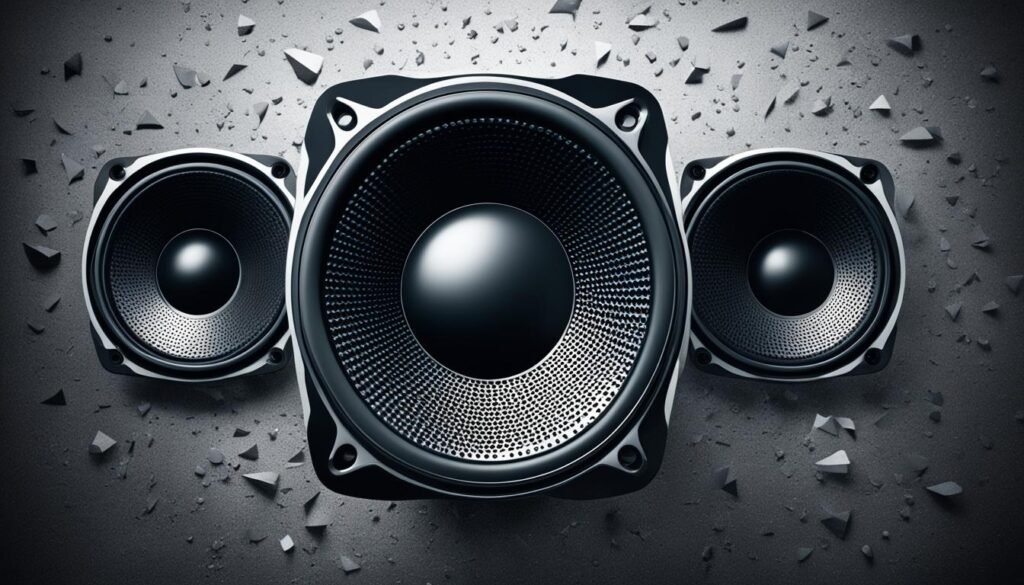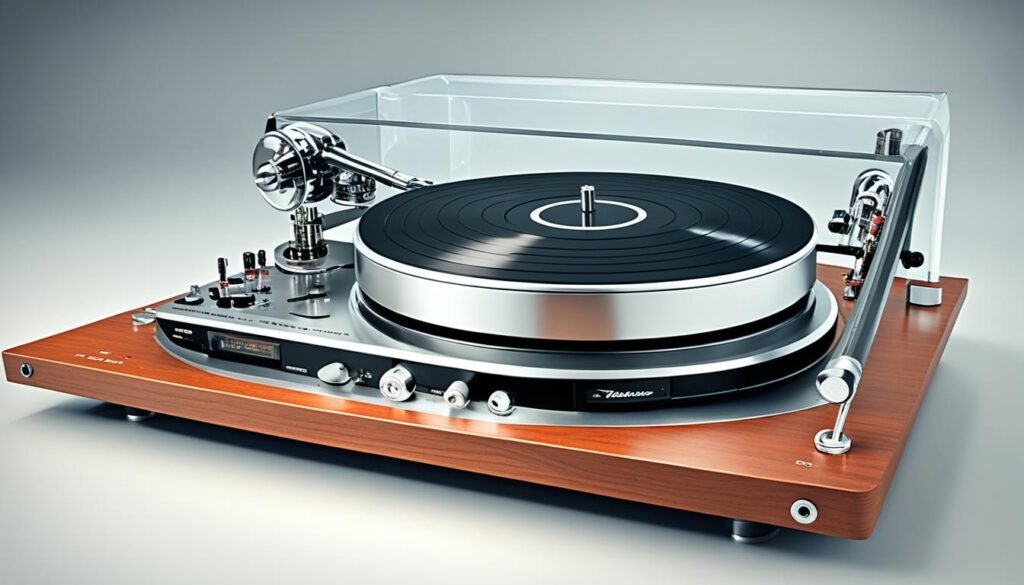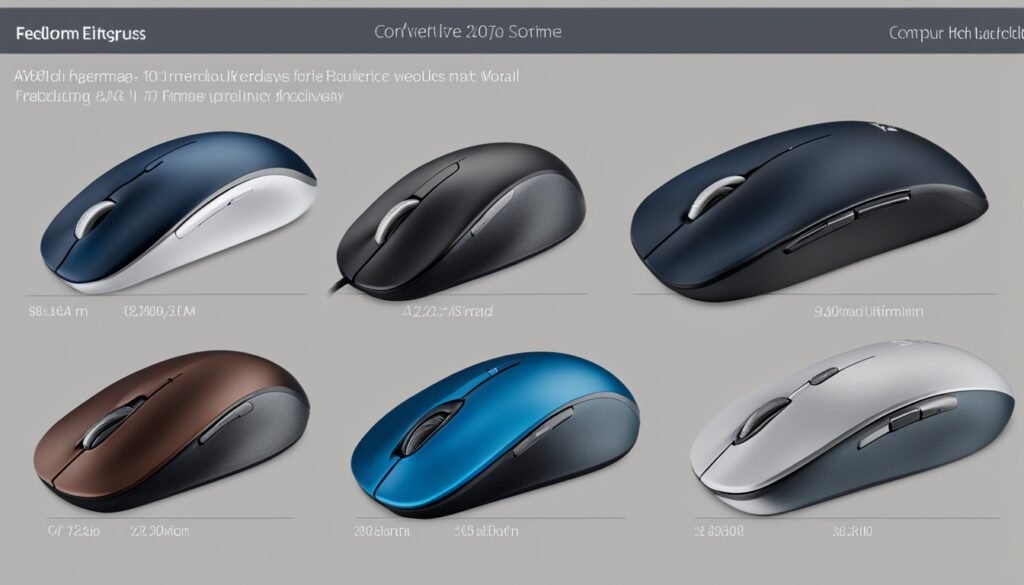Are you tired of lackluster bass in your car audio system? Are you seeking to unlock the secrets to deep, resonant bass that will transform your listening experience? Look no further. In this article, we delve into subwoofer box design, guiding you through the intricacies of building a custom subwoofer box for optimal bass performance. From understanding the importance of a subwoofer box in sound quality to choosing the right subwoofer and exploring different box designs, we have all the information you need to take your bass game to the next level.
Custom subwoofer boxes are the key to unleashing the true potential of your car’s sound system. They not only amplify the depth and clarity of the music but also personalize your audio setup. But what makes a subwoofer box design truly exceptional? And how can you optimize the performance of your subwoofer enclosure? Join us as we explore the world of subwoofer box design and discover the secrets to achieving deep bass mastery.
Importance of a Subwoofer Box in Sound Quality
A subwoofer box plays a crucial role in enhancing the sound quality of a car’s audio system. It prevents sound leaks, directs bass into the cabin, and eliminates resonance and distortion. The subwoofer box ensures deep and impactful bass by providing the appropriate volume for optimal subwoofer operation.
The design of the subwoofer box also significantly affects the system’s sound quality and accuracy. Different box designs, such as ported, sealed, bandpass, infinite baffle, and transmission line, have unique characteristics and sound signatures that can enhance or alter the bass response and overall sound experience.
To achieve the best sound quality and bass response, choosing the right subwoofer box design that complements your car audio system is essential. The subwoofer box should provide the appropriate enclosure volume for the subwoofer to deliver optimal performance, preventing distortion and allowing for clear and accurate bass reproduction.
Furthermore, the subwoofer box should be well-built and properly sealed to prevent sound leaks and resonance. A well-designed and constructed subwoofer box ensures that the bass output from the subwoofer is directed into the cabin, maximizing its impact and creating a more immersive listening experience.
Each type of subwoofer box design has advantages and characteristics. Ported boxes are known for their enhanced bass response and increased output, while sealed boxes offer tighter and more controlled bass. On the other hand, bandpass boxes emphasize specific low frequencies for a more focused bass experience. Infinite baffle and transmission line boxes provide unique sound signatures that cater to different audio preferences.
In summary, the subwoofer box is vital in achieving superior sound quality and bass response in a car audio system. By selecting the right box design and ensuring proper construction and sealing, you can enhance the listening experience and enjoy deep and impactful bass with minimal distortion and resonance.
Choosing the Right Subwoofer for Your Box
To achieve optimal bass performance, choosing the right subwoofer for your box is crucial. There are several factors to consider when selecting the perfect subwoofer to complement your audio system and deliver the desired bass.
Power Handling
One of the key factors to consider is the power handling capability of the subwoofer. It is important to match your amplifier’s power output with the subwoofer’s power handling specifications. This ensures that the subwoofer can handle the power without distortion or damage.
Sensitivity
Another important consideration is the subwoofer’s sensitivity. Sensitivity refers to how efficiently the subwoofer converts power into sound. A higher sensitivity rating means that the subwoofer will produce more sound output with less power. This is especially important if you have a lower-powered amplifier.
Mounting Depth
The mounting depth of the subwoofer should be compatible with the internal volume of your box design. Check the specifications of the subwoofer to ensure that it will fit properly in your box without any clearance issues.
Box Volume
Following the manufacturer’s recommendations for box volume is crucial to achieve maximum performance. Each subwoofer has an ideal volume range in which it can operate optimally. Selecting a box size that matches the subwoofer’s requirements is important to ensure the best possible bass response.
Configuration
The subwoofer’s configuration, whether a single or dual subwoofer setup, also plays a significant role in the overall sound balance and bass response. Consider the space in your vehicle and your preference when deciding on the subwoofer configuration.
By taking into account the power handling, sensitivity, mounting depth, box volume, and configuration of the subwoofer, you can make an informed decision and choose the right subwoofer that will deliver the deep, powerful bass you desire.
Essential Tools and Materials for Building a Subwoofer Enclosure
When constructing a high-quality subwoofer enclosure, having the right tools and materials is essential. Whether you’re a seasoned DIY enthusiast or a beginner, having the necessary equipment ensures a successful and secure build. Here are the vital tools and materials you’ll need to create a sturdy and well-designed subwoofer enclosure:
1. Jigsaw:
A jigsaw is a versatile tool for making precise cuts in various materials, including wood and MDF. It’s crucial to create the necessary openings and holes in the enclosure panels to accommodate the subwoofer and ports.
2. Screws:
Screws are crucial for joining the enclosure panels together securely. Make sure to use screws that are appropriate for the material you’re working with, such as fine-threaded screws for wood or MDF. This ensures a tight and durable bond.
3. Liquid Nails or Wood Glue:
Liquid nails or wood glue are essential for enhancing the strength and stability of the enclosure. Apply a thin adhesive layer along the mating surfaces before joining the panels. This helps create a secure and solid bond between the wood or MDF panels.
4. Silicon Caulk:
Silicon caulk is used to seal gaps or edges in the enclosure, ensuring an airtight and leak-free design. Apply silicon caulk along the internal seams and edges of the enclosure to prevent air leakage, which can impact the overall performance and bass output.
5. Router:
A router is a valuable tool for achieving professional-looking finishes and edge profiles on the enclosure panels. It allows you to create smooth and precise cuts, chamfers, and decorative details, giving your subwoofer enclosure a polished appearance.
6. Measuring Tape:
Accurate measurements are crucial for ensuring the enclosure panels’ proper fit and alignment. Using a measuring tape, measure the dimensions required for your subwoofer and the overall enclosure design. This helps ensure a seamless and well-fitting final product.
With these essential tools and materials at your disposal, you’ll be well-equipped to confidently tackle the construction of a subwoofer enclosure. Remember to prioritize safety by wearing appropriate gear, following manufacturer instructions, and maintaining a clean work area. With the right tools and materials, you can create a subwoofer enclosure that complements your audio system and delivers optimal bass performance and sound quality.
Safety Measures for Building a Subwoofer Enclosure
When building a subwoofer enclosure, prioritizing safety is paramount. By following the appropriate safety measures, you can ensure a smooth and secure construction process. Here are some essential safety guidelines to keep in mind:
Wear Appropriate Safety Gear
Always wear the appropriate safety gear when working on your subwoofer enclosure. This includes goggles to protect your eyes from splintered wood or flying debris and gloves to safeguard your hands from cuts and injuries. Wearing the right safety gear minimizes the risk of accidents and enhances overall safety.
Use Clamps for Secure Assembly
Utilize clamps to achieve precise cuts and secure assembly. Clamps hold the wood panels together firmly, allowing for accurate measurements and cleaner cuts. This extra stability prevents accidents and ensures the integrity of your subwoofer enclosure.
Follow the Manufacturer’s Instructions
Always follow the manufacturer’s instructions when using power tools and equipment. These instructions outline safety precautions for each tool, ensuring you operate them correctly and avoid potential hazards. Proper usage of tools promotes safety and reduces the risk of accidents.
Be Cautious of Sharp Edges
When working with wood panels, be cautious of sharp edges that can cause injuries. Sand down any rough or jagged edges to ensure a smooth and safe surface. Eliminating sharp edges mitigates the risk of cuts or scratches during construction.
Maintain a Clean Work Area
Keep your work area clean and organized to prevent accidents and tripping hazards. Dispose of waste materials properly and store tools and equipment in designated places. A clean, clutter-free work area promotes a safer and more efficient construction process.
By adhering to these safety measures, wearing appropriate safety gear, using clamps for secure assembly, following the manufacturer’s instructions, being cautious of sharp edges, and maintaining a clean work area, you can ensure a safe and enjoyable subwoofer enclosure construction experience.
Planning Your Subwoofer Box Design
When it comes to achieving the desired sound quality for your car audio system, planning the design of your subwoofer box is essential. Different box types have unique characteristics and sound signatures, including ported, sealed, bandpass, infinite baffle, and transmission line. Understanding how these designs impact sound quality, bass response, and accuracy is crucial in selecting the right box for your subwoofer.
Consider factors such as the box size, the type of enclosure, and the desired bass response when choosing a subwoofer box design. A ported box, for example, is known for its enhanced bass output and extended low-frequency response. On the other hand, a sealed box offers tighter and more accurate bass.
For those looking to balance efficiency and accurate bass reproduction, a bandpass box might be the ideal choice. The infinite baffle box design, also known as free-air mounting, eliminates the need for an enclosure and is suitable for open-air installations. Lastly, a transmission line box uses a series of chambers to improve bass response and reduce distortion.
Choosing the right subwoofer box design is essential for achieving the desired sound quality in your car audio system. By understanding the characteristics of different box types and considering your specific requirements, you can select a design that complements your sound system and enhances the overall listening experience.
Bandpass Subwoofer Box: Unlocking Deep Bass Extensions
A bandpass subwoofer box is the key to unlocking deep bass extensions in your car audio system. Designed to emphasize low-frequency sound waves, this specialized enclosure delivers powerful resonant bass that will elevate your listening experience.
The bandpass subwoofer box consists of the front and rear chambers. These chambers work together to optimize bass response and enhance sound output. The subwoofer is securely mounted inside the box, and the front chamber is acoustically coupled to the listening area, ensuring maximum bass impact.
Its carefully tuned design sets the bandpass subwoofer box apart, which emphasizes specific low frequencies while limiting subwoofer excursion. This results in a focused and controlled bass response, which is felt and heard.
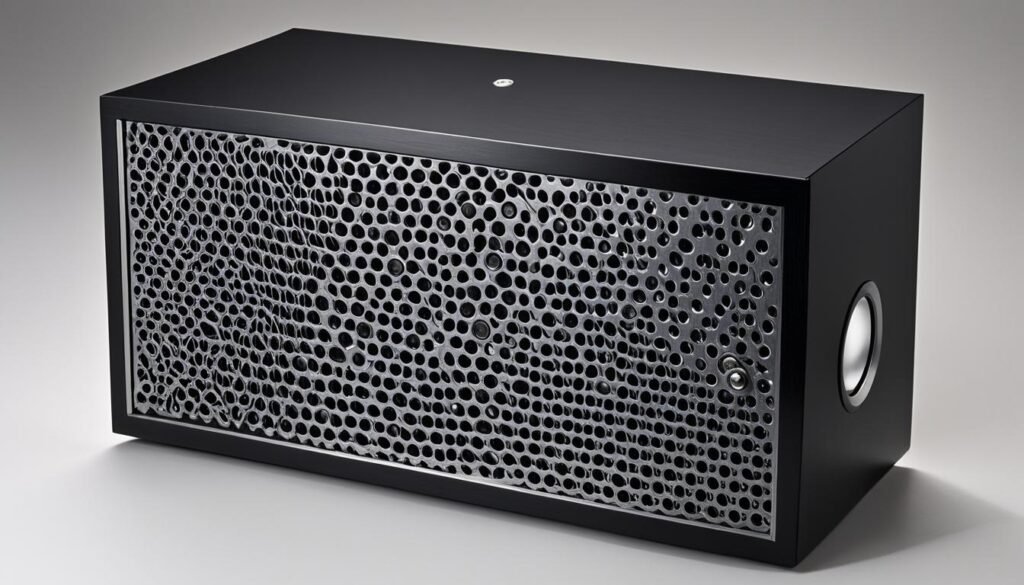
Understanding the advantages of a bandpass subwoofer box can help you decide on your audio system. With its unique enclosure design, optimized subwoofer mounting, and strategically placed front and rear chambers, this box type ensures you get the most out of your low-frequency sound waves.
Advantages and Disadvantages of Bandpass Subwoofer Boxes
Bandpass subwoofer boxes offer several advantages that can enhance the overall bass performance and create a more immersive listening experience. These advantages include:
- Superior Bass Extension: Bandpass subwoofer boxes are designed to emphasize low-frequency sound waves, allowing for deep bass extension and a more impactful bass experience.
- High Sound Pressure Levels: Bandpass subwoofer boxes’ unique design enables them to achieve higher sound pressure levels, resulting in a louder and more dynamic bass output.
- Efficient Power Handling: Bandpass subwoofer boxes are often optimized for efficient power handling, allowing them to produce powerful bass with less power consumption.
- Tight Transient Response: The enclosure design of bandpass subwoofer boxes helps to minimize resonances and distortions, resulting in a tighter and more accurate transient response.
However, it is important to consider the disadvantages of bandpass subwoofer boxes before making a decision:
- Larger Enclosure Size: Bandpass subwoofer boxes typically require larger enclosures than other subwoofer boxes, which may limit installation options or take up valuable trunk space.
- Customization Requirements: Designing and building a bandpass subwoofer box can be more complex and may require customization to achieve optimal performance, which might be challenging for beginners or those with limited knowledge of subwoofer box design.
- Limitations in Frequency Response: While bandpass subwoofer boxes excel at producing deep bass frequencies, they may be limited in reproducing higher frequencies, leading to potential tonal imbalances in the overall sound.
- Potential Durability Concerns: The design complexity and increased moving parts in bandpass subwoofer boxes can introduce potential durability concerns, requiring regular maintenance and monitoring to ensure long-term performance.
Understanding these advantages and disadvantages can help you make an informed decision when considering a bandpass subwoofer box for your audio system. It is important to evaluate your specific requirements, available space carefully and desired sound characteristics before selecting the right type of subwoofer box for your setup.
Subwoofer Box Placement: Optimizing Sound Quality
When optimizing sound quality and bass response in your car audio system, subwoofer box placement plays a crucial role. The placement of your subwoofer box can greatly impact the overall sound experience, taking it from good to exceptional. Different placement options offer unique advantages depending on your specific requirements and preferences.
Rear-Facing Placement: Placing your subwoofer box with the woofers facing the rear of the vehicle can optimize bass response and create a more immersive listening experience. This placement utilizes the trunk space effectively and allows the bass to resonate throughout the cabin for enhanced sound quality.
Upward-Facing Placement: Consider placing your subwoofer box with the woofers facing upwards to maximize bass resonance. This placement allows the bass frequencies to bounce off the vehicle’s floor, creating a fuller and richer sound with greater impact.
Under-Seat Placement: If space is a constraint in your vehicle, placing the subwoofers under the seats can be a space-saving solution that still delivers optimal bass frequencies. This placement ensures that the bass is directed toward the passengers for an immersive listening experience while maintaining trunk space for other belongings.
Custom-Built Enclosures: Consider investing in custom-built enclosures for the ultimate sound quality and bass reproduction. These enclosures are designed to perfectly fit your vehicle’s specifications, allowing for precise subwoofer box placement and optimal sound performance. Custom-built enclosures ensure that every aspect of your audio system is tailored to deliver the best possible sound quality.
Remember, the placement of your subwoofer box is just as important as its design and quality. Experiment with different placements and orientations to find the configuration that optimizes sound quality and bass response for your specific vehicle and personal preferences.
How Subwoofer Position Affects Your Listening Experience
The subwoofer’s position plays a crucial role in shaping your listening experience. By adjusting the subwoofer’s position, you can enhance the sound quality, bass response, and overall clarity of your audio system. Different room acoustics and subwoofer positions can create unique sound characteristics, allowing for a customized audio experience tailored to your preferences.
Experimenting with subwoofer placement lets you fine-tune the acoustic environment and achieve the desired sound balance. You can optimize the bass response by strategically positioning the subwoofer in relation to the room’s layout and speaker configuration. You can achieve precise sound reproduction through careful placement, emphasizing specific frequencies, and minimizing any acoustic anomalies in your listening area.
When positioning your subwoofer, consider room size, shape, and furnishings. Different locations can affect sound propagation and interaction with room boundaries, resulting in varying sound characteristics. By experimenting with subwoofer placement, you can uncover the optimal position that maximizes sound quality and bass response in your specific environment.
Remember to consider the subwoofer’s proximity to walls and corners, as these can impact the bass response. Placing the subwoofer near a wall or corner tends to amplify bass frequencies, resulting in a more prominent low end. However, excessive proximity to boundaries can also introduce unwanted resonances and boomy bass. It’s essential to strike a balance that achieves the desired bass extension without compromising sound quality.
Overall, the subwoofer position holds the key to unlocking the full potential of your audio system. By exploring different placements and considering room acoustics, you can create a unique and immersive listening experience with precise sound reproduction and deep bass response. So experiment with subwoofer placement, and discover the perfect position to elevate your audio enjoyment!
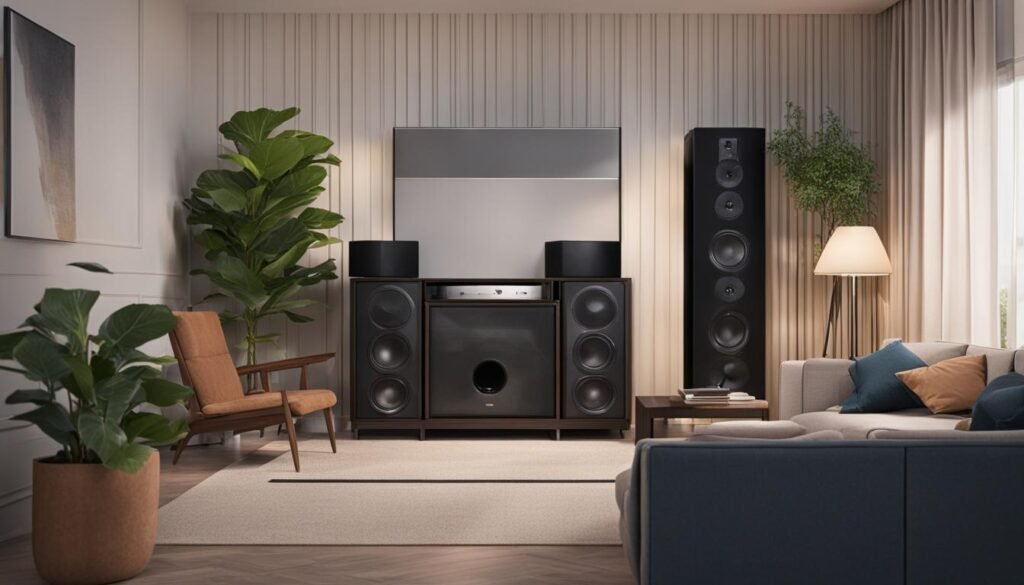
Frequently Asked Questions (FAQs) about Subwoofer Box Design and Placement
Do you have questions about subwoofer box design and placement? We’ve got you covered! Here are some commonly asked questions and their answers:
Q: How important is the subwoofer box in achieving optimal sound quality?
A: The subwoofer box plays a crucial role in enhancing sound quality. It helps prevent sound leaks, directs bass into the cabin, and eliminates resonance and distortion. The subwoofer box ensures deep and impactful bass by providing the appropriate volume for optimal subwoofer operation. The design of the subwoofer box also significantly affects the sound quality and accuracy of the system.
Q: What are the different types of subwoofer box designs?
A: There are several types of subwoofer box designs, including ported, sealed, bandpass, infinite baffle, and transmission line. Each design has unique characteristics and sound signatures that can enhance or alter the bass response and overall sound experience.
Q: How do I choose the right subwoofer for my box?
A: When selecting a subwoofer, consider factors such as power handling, sensitivity, mounting depth, box volume recommendations from the manufacturer, and the subwoofer’s configuration (single or dual). Matching the subwoofer’s specifications to your amplifier’s power output is crucial for proper performance.
Q: Where should I place my subwoofer box for the best sound quality?
A: The placement of the subwoofer box can significantly impact sound quality. Common placement options include rear-facing, upward-facing, under-seat, and custom-built enclosures. Each placement has its advantages in enhancing specific aspects of sound quality, such as bass response, sound dispersion, and optimal bass resonance.
Q: How does the subwoofer position affect the listening experience?
A: The position of the subwoofer can significantly impact the listening experience. Adjusting its position can enhance bass response, clarity, and overall sound quality. Different room acoustics and subwoofer positions can create unique sound characteristics, allowing for a customized audio experience.
These are just a few frequently asked questions about subwoofer box design and placement. If you have more questions or need further assistance, feel free to reach out to us!
Conclusion
Building a custom subwoofer box and optimizing its placement is crucial for achieving the best sound quality and bass response in your car audio system. By following the guidelines and considerations discussed in this article, you can create a subwoofer box design that delivers deep, resonant bass and enhances your listening experience.
When it comes to the subwoofer box design, it is important to choose the right size, shape, and type of enclosure that complements your subwoofer and sound preferences. Whether it’s a ported, sealed bandpass, infinite baffle, or transmission line box, each design has its unique characteristics that can affect the bass response and overall sound quality.
Equally important is the placement of the subwoofer box in your vehicle. Proper subwoofer box placement ensures optimal bass resonance and sound dispersion, creating a well-balanced audio experience. Consider options such as rear-facing placement, upward-facing placement, under-seat placement, or custom-built enclosures depending on your car’s interior and available space.
By paying attention to both subwoofer box design and placement, you can achieve the best subwoofer performance, deep bass reproduction, and excellent sound quality in your car audio system.
FAQ
What role does a subwoofer box play in enhancing sound quality?
A subwoofer box prevents sound leaks, directs bass into the cabin, and eliminates resonance and distortion. It also provides the appropriate volume for optimal subwoofer operation, ensuring deep and impactful bass.
What factors should I consider when choosing a subwoofer for my box?
Considerations include power handling, sensitivity, mounting depth, recommended box volume from the manufacturer, and the subwoofer configuration (single or dual). Matching the subwoofer specifications to your amplifier’s power output is essential for proper performance.
What tools and materials do I need to build a subwoofer enclosure?
Essential tools include a jigsaw, screws, liquid nails or wood glue, silicon caulk, a router, and a measuring tape. These tools ensure proper construction and a secure bond in the subwoofer enclosure.
What safety measures should I take when building a subwoofer enclosure?
Always wear appropriate safety gear, use clamps to secure wood panels, follow the manufacturer’s instructions for power tool usage, sand sharp edges, and maintain a clean and organized work area to prevent accidents.
What should I consider when planning my subwoofer box design?
Consider factors such as box size, enclosure type, and desired bass response. Different box types, such as ported, sealed, bandpass, infinite baffle, and transmission line, have unique characteristics and sound signatures that can enhance the bass response and overall sound experience.
What is a bandpass subwoofer box, and what are its advantages?
A bandpass subwoofer box features dual chambers that work harmoniously to optimize bass response. Its advantages include superior bass extension, high sound pressure levels, efficient power handling, and tight transient response.
Are there any disadvantages to using a bandpass subwoofer box?
Yes, disadvantages can include larger enclosure size, customization requirements, limitations in frequency response, and potential durability concerns. It’s important to weigh these factors when considering a bandpass subwoofer box for your audio system.
How does subwoofer box placement affect sound quality?
Different placement options, such as rear-facing, upward-facing, under-seat, and custom-built enclosures, each have their advantages in enhancing specific aspects of sound quality, including bass resonance and sound dispersion.
How does the subwoofer position impact the listening experience?
Adjusting the position of the subwoofer can enhance bass response, clarity, and overall sound quality. Different room acoustics and subwoofer positions can create unique sound characteristics, allowing for a customized audio experience.
What are some frequently asked questions about subwoofer box design and placement?
For frequently asked questions and answers about subwoofer box design and placement, please visit the relevant section above.
Images Credit: All images are AI-Generated.
Disclaimer: The images, videos & logos displayed on bestfordaily.com are used for informational purposes only. We make every effort to credit the original copyright holder whenever possible. If you are the owner of any content used on this blog and do not wish for it to appear here, please contact us.
Author
-

Hey there! I'm Andrew Reed, and I live for the thrill of writing reviews. Dive into my world at bestfordaily.com, where I unpack stories behind products and experiences. I'm all about sharing my unique take on things, infusing each review with my youthful enthusiasm and a dash of social flair. Join me on this exciting journey—I promise you won't just read reviews; you'll experience them!
View all posts



